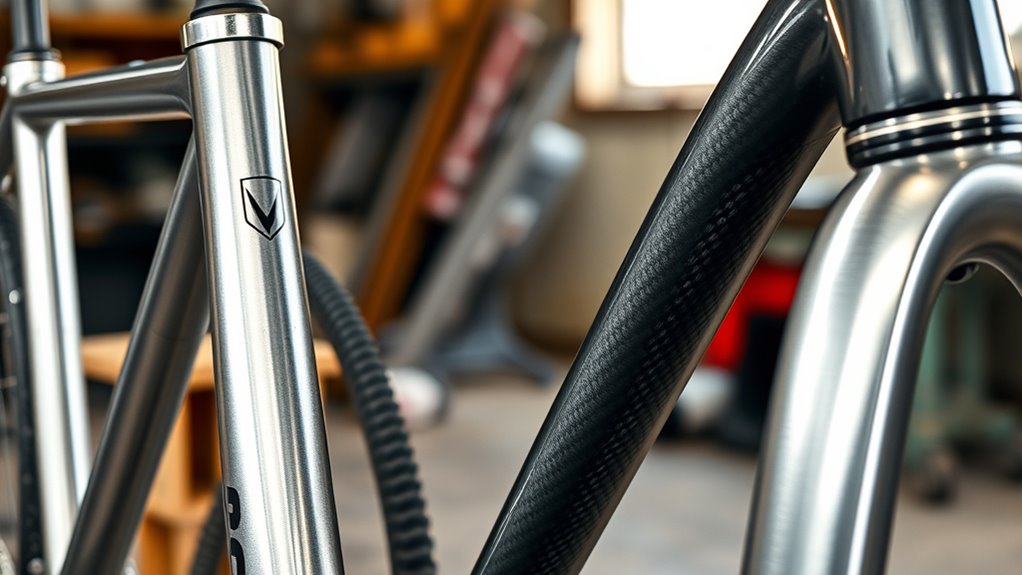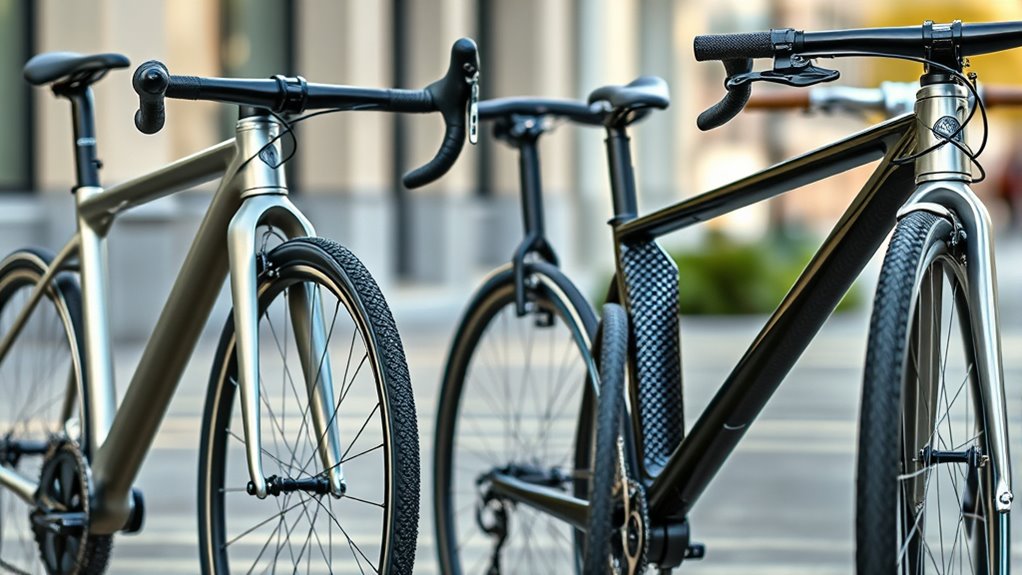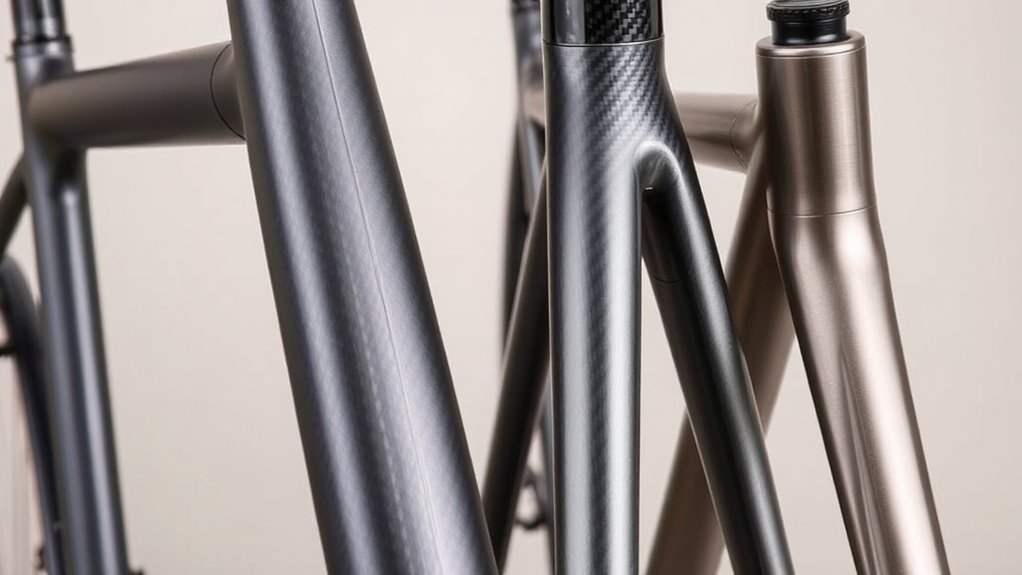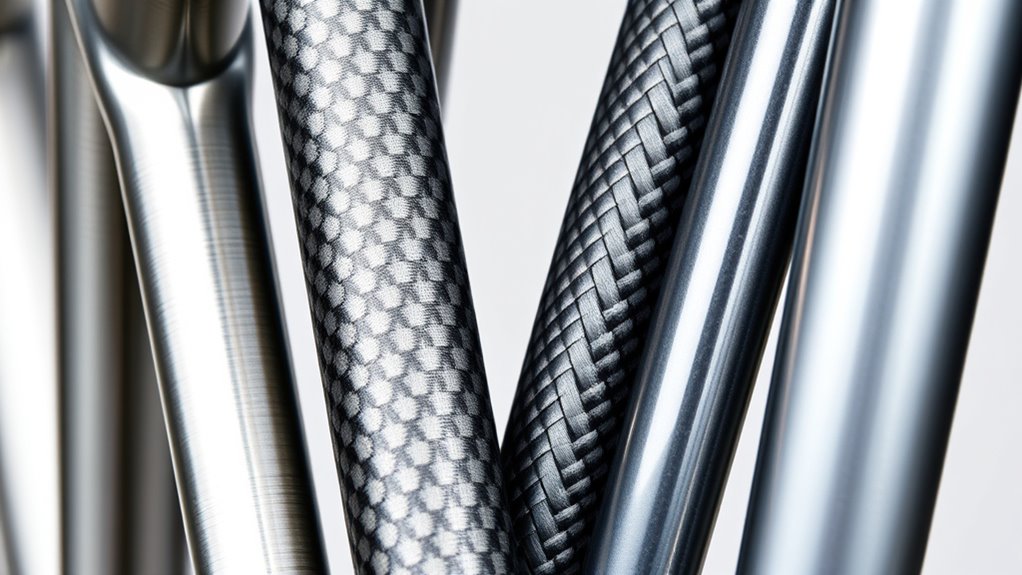Choosing your bike’s frame material affects weight, durability, ride comfort, and environmental impact. Aluminum frames are lightweight, stiff, and affordable, making them popular for many riders. Carbon fiber offers high strength and low weight, ideal for speed and performance. Steel and titanium are tough, long-lasting, and provide a smoother ride but tend to be heavier and more costly. Understanding these options helps you make the best choice for your style—there’s plenty more to discover.
Key Takeaways
- Aluminum frames are lightweight, stiff, and corrosion-resistant, making them popular for versatile and affordable bikes.
- Carbon fiber offers high strength-to-weight ratio, aerodynamic shaping, and vibration absorption, ideal for performance-oriented cycling.
- Steel frames are durable, easily repairable, and provide a smooth ride, suitable for touring and touring bikes.
- Titanium combines strength, lightness, and corrosion resistance, with a higher cost and environmentally conscious sourcing.
- Material choice impacts ride quality, durability, cost, and environmental impact, influencing overall bike performance and sustainability.
The Characteristics of Aluminum Bicycle Frames

Aluminum bicycle frames are popular because they offer a lightweight yet strong option for riders. Their frame geometry can be easily customized, allowing you to choose aggressive or relaxed riding positions that suit your style.
Aluminum’s natural sleek appearance adds to the aesthetic appeal of your bike, making it look modern and sharp. The material’s smooth welds give the frame a clean, polished look, enhancing its visual appeal.
Plus, aluminum frames resist rust and corrosion, keeping your bike looking new longer. This combination of durability and style means you get a frame that not only performs well but also looks great.
Whether you want a nimble road bike or a sturdy mountain bike, aluminum’s versatility makes it an excellent choice to match your preferences.
Advantages and Disadvantages of Carbon Fiber Frames

Carbon fiber frames are known for being incredibly lightweight, which can boost your riding performance. However, they often come with higher costs and concerns about durability over time. Understanding these trade-offs helps you decide if they’re the right choice for your riding style. Additionally, proper care and maintenance are essential for prolonging the lifespan of carbon fiber frames and ensuring safety during rides. Advances in material technology continue to improve the resilience and longevity of carbon fiber components, making them a more viable option for many cyclists. Regular inspection and damage assessment can help prevent catastrophic failures and extend the frame’s usefulness. Moreover, understanding expiration of materials used in manufacturing can influence the overall durability and safety of the frame over the years. Incorporating advanced manufacturing techniques can also enhance the strength and reliability of carbon fiber frames, further supporting their durability.
Lightweight Performance Benefits
Because of their exceptional strength-to-weight ratio, carbon fiber frames are prized for delivering lightweight performance that can give you a competitive edge. Their design allows for more aerodynamic shapes, reducing drag and increasing speed. Manufacturing techniques, like lay-up processes and precise layering, ensure these frames are both lightweight and stiff, enhancing power transfer and responsiveness. The lightweight nature means you can climb hills more easily and accelerate quickly, making your ride more efficient. Carbon fiber’s ability to be molded into complex, aerodynamic forms also contributes to improved handling and comfort without adding weight. Material properties play a crucial role in optimizing these benefits, making carbon fiber frames ideal for riders seeking maximum performance, especially in racing or high-performance scenarios. In addition, manufacturing techniques are continually evolving to improve durability and impact resistance of these advanced frames. Incorporating specialized reinforcement techniques can further enhance the durability and longevity of the frames under various riding conditions. Furthermore, advancements in fiber orientation help tailor the stiffness and flexibility to meet specific riding needs, ensuring optimal performance. Additionally, innovative manufacturing methods are being developed to enhance impact resistance and extend the lifespan of carbon fiber frames.
Cost and Durability Concerns
While carbon fiber frames offer impressive performance benefits, their higher cost can be a significant barrier for many cyclists. When doing a price comparison, you’ll find they’re usually more expensive than aluminum or steel options. This cost stems from manufacturing complexity, which involves precise layering and curing processes that require specialized equipment. Track development techniques are crucial in creating compelling trailer music narratives that resonate emotionally with audiences. Consider these points:
- The initial price is steep, making it less accessible for casual riders.
- The manufacturing process is intricate, increasing production time and cost.
- Despite their durability, carbon frames can crack or splinter under severe impact, leading to costly repairs or replacements.
- The cost factors associated with carbon fiber production can fluctuate based on advancements in manufacturing technology and material sourcing.
- Additionally, the material sourcing for carbon fiber involves extracting and processing raw materials, which can impact overall environmental sustainability and cost.
The Durability and Strength of Steel Frames

Steel frames are renowned for their exceptional durability and strength, making them a popular choice among cyclists who prioritize reliability. They can withstand rough terrain and heavy use without cracking or breaking easily.
However, frame corrosion is a concern, especially if the bike isn’t properly maintained or stored in humid environments. Regular inspections help you spot rust early, and applying appropriate repair techniques, like sanding and repainting, can extend your frame’s lifespan.
Steel’s inherent strength allows for easier repairs compared to other materials, meaning minor dents or damages can often be fixed without replacing the entire frame.
Titanium: The Lightweight and Long-Lasting Choice

Ever wonder why titanium is highly regarded among serious cyclists? Its unique blend of durability and aesthetics makes it a top choice. Titanium frames are lightweight yet incredibly strong, offering a smooth ride that withstands the test of time. Additionally, titanium’s trustworthiness in long-term use ensures your bike remains reliable season after season. The corrosion resistance of titanium also contributes to its longevity, making it a durable investment for dedicated riders. Furthermore, its lightweight nature allows for improved speed and handling, which is especially appreciated by competitive cyclists. The biocompatibility of titanium also means it’s less likely to cause skin irritation, adding to its appeal for many riders.
Comparing Weight and Stiffness Across Materials

When choosing a bike frame, you’ll notice that aluminum is both lightweight and rigid, making it great for speed.
Carbon frames are even lighter and excel in stiffness, enhancing performance on tough climbs or sprints.
Steel and titanium, while heavier, offer flexibility and durability, which can improve comfort on long rides.
Aluminum: Light and Rigid
Have you ever wondered why aluminum is a popular choice for bicycle frames? Its combination of being lightweight and rigid makes it ideal for performance and speed. Imagine:
- A frame that feels agile and responsive under your hands.
- Smooth finishes that highlight aesthetic customization options.
- Advanced manufacturing techniques that guarantee durability and precision. sustainable manufacturing practices help ensure aluminum’s environmental benefits and long-term viability.
Aluminum’s low density keeps the weight down, making your ride faster and easier to handle. Its high stiffness means more efficient power transfer, translating your effort directly into movement.
Plus, aluminum frames are versatile in aesthetics, allowing for vibrant colors and sleek designs. Manufacturing techniques like hydroforming and welding enhance strength and appearance, giving you a frame that’s both functional and visually appealing. Cookies play a role in improving your browsing experience and customizing content.
That’s why aluminum remains a top favorite for cyclists seeking a perfect balance of weight and stiffness.
Carbon: Ultra-Light, Stiff
Carbon fiber stands out because it’s remarkably lightweight yet incredibly stiff, making it a top choice for performance-focused cyclists. Its low weight reduces rider fatigue, while the stiffness translates to efficient power transfer. The material’s high strength-to-weight ratio means you get a durable frame that’s easy to handle at high speeds. Additionally, customization options allow for tailored designs that suit individual preferences and riding styles. While more complex and costly to produce, the benefits of carbon’s lightness, stiffness, and aesthetic versatility make it a preferred choice for competitive cycling and enthusiasts seeking top-tier performance. Furthermore, advancements in manufacturing techniques like layup processes have improved consistency and quality control in carbon frames, enhancing their reliability and performance.
Steel & Titanium: Heavier, Flexible
Steel and titanium frames tend to be heavier than their carbon counterparts, but they offer a different set of advantages. They excel in durability and flexibility, making your ride smoother over rough terrain.
Their weight allows for more relaxed frame geometry, enhancing comfort on long rides. When considering color options, steel and titanium frames often feature classic finishes and custom paint jobs, giving you more personalization choices.
- You can choose a frame that absorbs road vibrations, reducing fatigue.
- Their weight provides stability, especially at high speeds.
- Flexibility in design means you can select unique color options and frame geometries tailored to your riding style.
These qualities make steel and titanium ideal for riders valuing comfort, durability, and aesthetic customization.
Ride Quality and Comfort Offered by Different Frame Materials

While the choice of frame material considerably influences a bike’s ride quality and comfort, some materials inherently absorb shocks better than others. Aluminum frames offer a stiff, responsive ride, but they can feel harsher without proper ergonomic design. For those interested in customization and creative expression, fabric decorating markers can be used to personalize bike accessories or gear, adding a unique touch to your cycling experience. Carbon fiber excels at absorbing vibrations, providing a smooth and comfortable experience, especially on rough roads. Steel and titanium, known for their flexibility, naturally dampen shocks, delivering a plush ride that reduces fatigue. Beyond comfort, the aesthetic appeal of these materials also plays a role in your experience; sleek carbon frames can feel as good as they look. Ultimately, your choice impacts ride quality, balancing comfort with performance and style to match your riding preferences.
Cost Considerations for Various Frame Types

When choosing a bicycle frame, you’ll notice significant differences in material costs, which can impact your budget upfront. While some materials may seem more expensive initially, they often offer better durability and resale value over time. Considering these long-term benefits can help you make a smarter investment in your ride. Additionally, understanding the material properties of each frame type can influence your decision based on strength, weight, and overall performance. Incorporating mindset principles such as patience and gratitude during your decision-making process can also lead to a more satisfying purchase.
Material Cost Differences
The cost of bicycle frames varies considerably depending on the material used, affecting your overall budget and options. When considering material cost differences, think about how frame manufacturing and material sourcing influence prices.
Generally,:
- Aluminum frames are affordable, thanks to widespread material sourcing and efficient manufacturing processes.
- Steel frames tend to be moderate in price, with durable material sourcing balancing cost and longevity.
- Carbon and titanium frames are more expensive due to specialized material sourcing and complex frame manufacturing.
Carbon fiber involves high-quality sourcing and precise manufacturing, raising costs. Titanium requires rare, high-grade sourcing, making it the priciest option.
Your choice depends on balancing initial costs with desired performance and durability.
Long-Term Investment Value
Choosing the right frame material isn’t just about initial costs; it also involves considering long-term value. Over time, materials like steel and titanium tend to hold their resale value better due to durability and timeless frame aesthetics.
Carbon frames, while often more expensive upfront, may depreciate faster because of concerns over damage and limited repair options. Aluminum frames usually offer a balance, with decent resale value and lower maintenance costs.
When evaluating long-term investment, think about how well the frame maintains its appearance and function. A bike with a durable, attractive frame can be more appealing on the resale market, ultimately saving you money.
Weighing these factors helps ensure your choice remains a smart investment beyond just the initial purchase.
Maintenance and Longevity of Bicycle Frame Materials

Maintaining your bicycle frame properly is essential to guarantee its longevity, regardless of the material. Regular inspections help spot issues early, such as chipped paint or cracks.
Keep an eye on:
- The frame paint, which protects against corrosion and damage, especially for steel and aluminum.
- The manufacturing processes, which influence how durable the frame is and how well it resists wear over time.
- Proper cleaning and lubrication, preventing dirt buildup and rust for steel and ensuring smooth performance for all materials.
For carbon frames, avoid impacts that can weaken the structure.
Titanium and steel frames generally require less maintenance but still benefit from periodic checks. Proper care extends your bike’s lifespan and preserves value.
Environmental Impact and Sustainability Aspects

Considering the environmental impact of bicycle frame materials is essential when selecting your bike, as manufacturing processes and raw materials influence sustainability. Aluminum and steel often benefit from recycling initiatives, making them more eco-friendly options, since they can be recycled repeatedly without losing quality.
Carbon fiber manufacturing involves energy-intensive processes, but efforts in eco-friendly manufacturing are reducing its footprint.
Titanium is highly durable and recyclable, which supports sustainability, though its extraction can be more impactful.
By choosing materials with strong recycling programs and environmentally conscious production methods, you help reduce waste and lower carbon emissions.
Opting for bikes made with recycled or sustainably sourced materials aligns with your environmental values and promotes a greener future for cycling.
Choosing the Right Material for Your Riding Style

Your riding style plays a crucial role in selecting the right bicycle frame material, as each material offers distinct benefits suited to different needs.
Choosing the right bike material depends on your riding style and personal preferences.
If you prefer a lightweight, stiff frame for speed, carbon is ideal.
For durability and a smooth ride, steel or titanium work well.
For casual riding and versatility, aluminum might suit you best.
Consider frame color options to match your style and preferences.
Also, think about bike frame geometry—racing bikes typically have aggressive angles, while comfort bikes favor relaxed designs.
Your riding style determines whether you need a rigid, responsive frame or one that absorbs shocks.
Matching your needs with the right material, color choices, and geometry ensures a bike that feels natural and supports your riding experience.
Frequently Asked Questions
How Do Frame Materials Affect Bike Resale Value?
When considering how frame materials affect your bike’s resale value, remember that market value depends on demand and material durability.
Bikes made from durable materials like steel and titanium often hold their value better because they last longer and appeal to buyers seeking reliability.
Conversely, lightweight options like carbon may depreciate more quickly due to potential damage concerns.
Your choice of frame material influences how much you can recoup when selling your bike later.
Are There Any Health Concerns With Specific Frame Materials?
Imagine your bike frame as a suit of armor; some materials are smoother, while others might carry hidden threats. If you have frame material allergies or sensitivities, certain metals like aluminum or steel could cause skin irritation or allergic reactions.
Chemical treatments used to enhance durability might also trigger skin or respiratory issues. Always check for potential allergies and ask about chemical processes, ensuring your ride stays safe and comfortable.
Can Frame Materials Be Recycled or Repurposed?
You can definitely explore frame material recycling and bike material repurposing. Aluminum and steel frames are highly recyclable, often melted down and reused without losing quality.
Titanium can also be recycled, though it’s less common. Carbon fiber, however, is more challenging to recycle due to its composite nature, but some companies are developing ways to repurpose it into new products.
Recycling helps reduce environmental impact and supports sustainable biking.
How Do Frame Materials Influence Bike Repairability?
Frame materials markedly impact your bike’s repairability. You find that steel and aluminum offer easier maintenance and repair due to their durability and availability of spare parts.
Carbon and titanium, while lightweight, often require specialized tools and skills, making repairs more complex and costly. Your choice affects how quickly you can fix common issues, with durable materials generally providing a more straightforward repair process.
What Are the Best Frame Materials for Extreme Weather Conditions?
While it’s wise to contemplate weather resistance, some materials stand out for their enduring material durability. For extreme weather conditions, titanium and steel are your best bets, as they handle moisture and temperature swings gracefully.
Aluminum and carbon may face challenges like corrosion or temperature sensitivity. You’ll want a frame that’s built to last through varying climates, offering reliable performance and peace of mind wherever you ride.
Conclusion
Think of choosing your bike frame like selecting a trusted companion on your journey. Each material offers unique strengths and quirks—aluminum’s agility, carbon’s finesse, steel’s resilience, titanium’s lightness. Your choice shapes your adventure, much like a seasoned guide steering through varied terrains. By understanding these qualities, you navigate your cycling story with confidence, forging a bond that endures, adapts, and propels you forward—your perfect frame awaits to become part of your ongoing odyssey.









